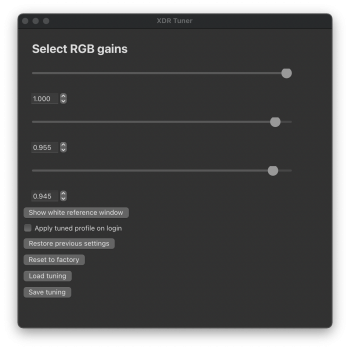Hi!
I just wrote a tool in order to fix the bad white point on my 16.2" 2021 MacBook Pro.
After checking in a shop I saw that there was noticeable inconsistency in factory calibration between units, leading to some displays being more red, more blue, or worse like mine with a depressing blue-green tint.
Frustrated between the choice of giving it back to Apple for fixing for unknown results or requesting a refund and wait for months to get a replacement, I researched solutions to fix it myself.
Unfortunately each of the calibration options had dealbreakers, namely:
Fortunately, ColorSync supports loading correction tables into the display (or display controller) with at least 10-bit precision in a way that makes it easy to alter the "gain" of red, green and blue channels as well as their overall gamma.
Then, XDR Tuner takes the factory ICC profile generated by the system from display data, modifies the max and gamma values in its vcgt table according to your config and apply it.
That way, it is possible to adjust the white point and every other follows accordingly.
HDR works just as expected is is corrected the same. True Tone and Night Shift are good to go as well.
I thought I might not be the only one that needs this fix: Everybody out here working with color will need to match their Liquid Retina XDR display with a reference monitor and like me might not want to experience the same limitations.
Now my MacBook Pro XDR display matches with the other calibrated displays I have, with the added XDR capability which is frankly breathtaking. I look forward to play with grading HDR video in Resolve soon.
Here's the tool:

 github.com
github.com
I hope it'll be useful to you as well, let me know if you need any help with using it or tuning your display.
I just wrote a tool in order to fix the bad white point on my 16.2" 2021 MacBook Pro.
After checking in a shop I saw that there was noticeable inconsistency in factory calibration between units, leading to some displays being more red, more blue, or worse like mine with a depressing blue-green tint.
Frustrated between the choice of giving it back to Apple for fixing for unknown results or requesting a refund and wait for months to get a replacement, I researched solutions to fix it myself.
Unfortunately each of the calibration options had dealbreakers, namely:
- With a profile generated by X-Rite i1Profiler and a i1 Display Pro:
- Losing HDR capability altogether
- Wrong color matrix for colorspace conversion
- With a "fine-tuned" custom display preset:
- Losing 1600 nits HDR peak brightness: limit to 1000-nits instead.
- Losing automatic brightness
- Losing the ability to adjust brightness altogether
Fortunately, ColorSync supports loading correction tables into the display (or display controller) with at least 10-bit precision in a way that makes it easy to alter the "gain" of red, green and blue channels as well as their overall gamma.
Then, XDR Tuner takes the factory ICC profile generated by the system from display data, modifies the max and gamma values in its vcgt table according to your config and apply it.
That way, it is possible to adjust the white point and every other follows accordingly.
HDR works just as expected is is corrected the same. True Tone and Night Shift are good to go as well.
I thought I might not be the only one that needs this fix: Everybody out here working with color will need to match their Liquid Retina XDR display with a reference monitor and like me might not want to experience the same limitations.
Now my MacBook Pro XDR display matches with the other calibrated displays I have, with the added XDR capability which is frankly breathtaking. I look forward to play with grading HDR video in Resolve soon.
Here's the tool:
GitHub - supercurio/xdr-tuner: Adjust the white point, gamma or make your XDR display darker without losing HDR peak luminance or the ability to adjust display brightness
Adjust the white point, gamma or make your XDR display darker without losing HDR peak luminance or the ability to adjust display brightness - supercurio/xdr-tuner
I hope it'll be useful to you as well, let me know if you need any help with using it or tuning your display.


